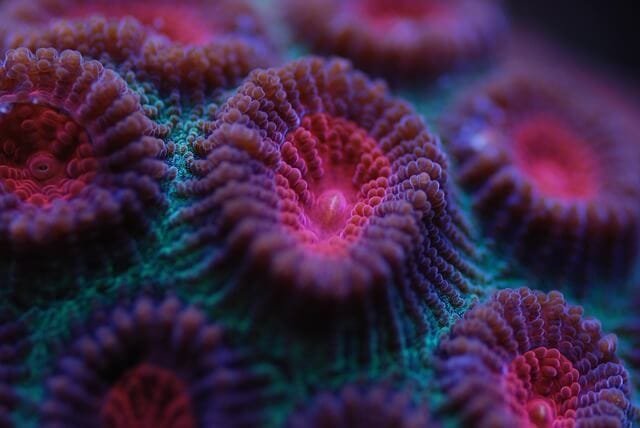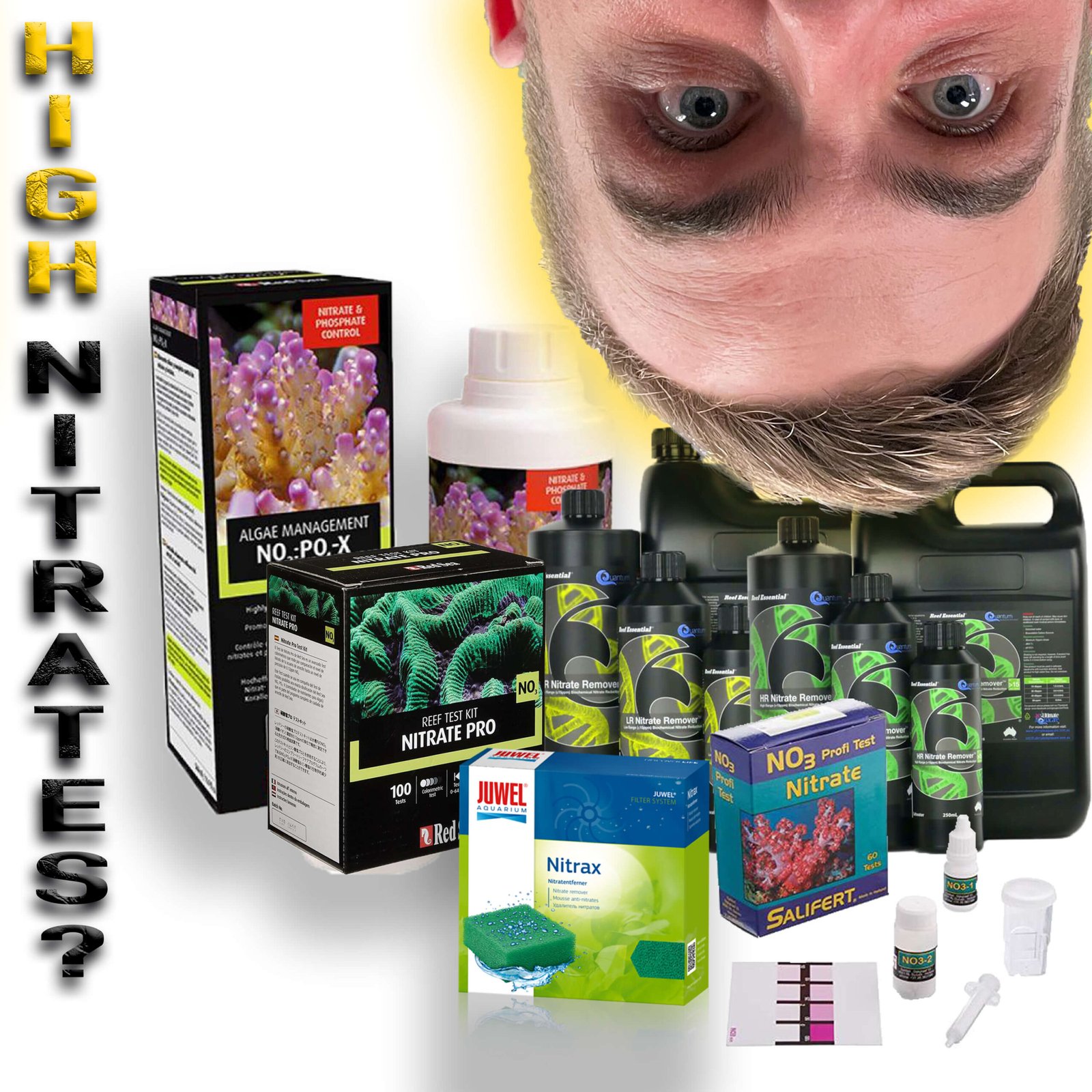Say Goodbye to High Nitrates Once & For All
Maintaining a healthy saltwater aquarium can be challenging, even for experienced aquarists. As the saying goes, “We don’t keep fish, we keep water.” Ensuring optimal water quality is crucial for the survival of fish, corals, and other marine life.
One of the most common water quality issues aquarists face is high nitrate levels. While some nitrates are essential for coral growth and biological balance, excessive amounts can lead to poor water conditions, algae outbreaks, and stressed marine life.
In this guide, we will cover:
- How the Nitrogen Cycle works in a reef aquarium
- The common causes of high nitrate levels
- The negative effects of excessive nitrates
- Effective methods for controlling nitrate levels

By understanding and managing nitrates, you can maintain a thriving reef tank and prevent many of the common issues associated with poor water quality.
Understanding the Nitrogen Cycle
The Nitrogen Cycle is the biological process that breaks down organic waste in an aquarium. It consists of three main stages:
1. Ammonification
- Fish waste, uneaten food, and decaying organic matter break down into ammonium (NH₄⁺).
- This process is facilitated by bacteria that rapidly convert waste into a more manageable form.
2. Nitrification
- Nitrosomonas bacteria oxidise ammonium into nitrite (NO₂⁻), a toxic compound.
- Nitrobacter bacteria further convert nitrite into nitrate (NO₃⁻), which is less toxic but can accumulate over time.
3. Denitrification
- In low-oxygen environments (e.g., deep sand beds, live rock), anaerobic bacteria convert nitrate into nitrogen gas (N₂), which is released into the atmosphere.
- This is the only natural way nitrate leaves the system without human intervention.

💡 Important Note: While nitrification happens quickly in oxygen-rich areas, denitrification is a slow process and often not sufficient on its own to remove excess nitrate from an aquarium.
Common Causes of High Nitrates
Nitrates can accumulate due to several factors, and identifying the root cause is key to long-term control.
1. Overfeeding
- Fish eat as much as they are given, often leading to excess food settling and decaying in the tank.
- Overfeeding increases organic waste, which accelerates nitrate buildup.
2. Poor Filtration
- A weak or inadequate filtration system leads to inefficient waste removal.
- If mechanical, biological, and chemical filtration are not optimised, waste accumulates quickly.
3. Lack of Water Changes
- Without regular water changes, nitrates steadily increase over time.
- A tank with no water changes will eventually become toxic to its inhabitants.
4. Inadequate Water Flow
- Poor circulation causes dead zones, where waste settles and nitrates spike.
- This often leads to cyanobacteria and dinoflagellate blooms, which thrive in nutrient-rich stagnant areas.
5. Decaying Organic Material
- Dead fish, corals, or invertebrates left unnoticed in the tank release ammonia and nitrates into the water.
- Decomposing plant matter, including macroalgae that isn’t regularly pruned, can also contribute to rising nitrate levels.
6. Low-Quality Water Source
- Using tap water without proper filtration or RO/DI water with high total dissolved solids (TDS) can introduce additional nitrates into the system.
Effects of High Nitrate Levels
Excessive nitrates can cause several serious issues in a marine aquarium:
1. Coral & Invertebrate Stress
- Corals and invertebrates are highly sensitive to nitrate fluctuations.
- Long-term exposure to high nitrate levels (>20ppm) can cause coral bleaching and slow growth.
2. Increased Disease & Fish Stress
- High nitrates weaken the immune systems of fish, making them more susceptible to disease.
- Certain fish, like tangs and butterflyfish, are particularly vulnerable to poor water quality.
3. Algae Blooms
- Elevated nitrate levels promote excessive algae growth.
- Hair algae, cyanobacteria, and dinoflagellates thrive in high-nutrient environments, taking over the tank.
4. Reduced Oxygen Levels
- Decaying organic matter and excessive algae consume oxygen, leading to low oxygen conditions for fish and corals.
5. Poor Aesthetic & Maintenance Issues
- High nitrates cause water discolouration, cloudiness, and foul odours, making maintenance more difficult.
How to Reduce & Control Nitrates
Reducing nitrate levels requires a combination of natural processes and active maintenance. Here’s how:
1. Regular Water Changes
✅ Perform 10-20% water changes weekly to dilute excess nitrates.
✅ Use RO/DI water to avoid adding nitrates from tap water.
2. Improve Filtration
✅ Install a high-quality protein skimmer to remove organic waste before it breaks down.
✅ Use filter socks or sponges to trap debris, but clean them regularly.
✅ Add bio-media (e.g., ceramic rings, bio-blocks) to enhance biological filtration.
3. Increase Denitrification
✅ Add live rock and deep sand beds to promote anaerobic bacteria growth.
✅ Consider biopellets or carbon dosing (e.g., Red Sea NO3PO4X) to fuel beneficial bacteria.
4. Enhance Water Flow
✅ Use powerheads or wave makers to improve circulation and prevent waste buildup.
✅ Avoid dead spots, especially in large tanks with complex rock structures.
5. Introduce Macroalgae & Refugiums
✅ Grow Chaetomorpha or Caulerpa macroalgae to absorb nitrates naturally.
✅ Use a refugium light to encourage macroalgae growth and nutrient export.
6. Feed Smartly & Reduce Waste
✅ Feed fish small, controlled portions to prevent excess food from decaying.
✅ Rinse frozen foods before feeding to remove phosphate & nitrate-laden juices.
7. Use Chemical Nitrate Removers (If Necessary)
✅ Activated carbon and nitrate-removing media (e.g., Seachem Matrix, NO3-PO4X) can provide additional control.
✅ These should be used alongside natural filtration, not as a sole solution.
Final Thoughts
Keeping nitrate levels under control is crucial for a healthy, thriving saltwater aquarium. By understanding the nitrogen cycle, identifying problem areas, and taking proactive measures, you can prevent high nitrate issues and maintain a balanced marine ecosystem.
At AquariumKeeping.co.uk, we’re always happy to help with any questions regarding nitrate control or reef tank maintenance. Feel free to reach out through our website or social media for expert advice!









Thanks so much for the explanation it has work wonders for my 100 gallons reef tank thanks again for taking the time to teach as how to be a better reef and fish tank persons